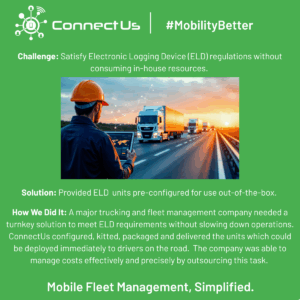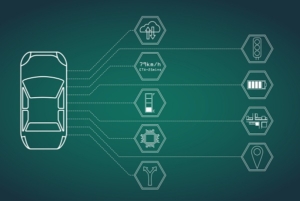Eliminating Fleet Connectivity Dead Zones: How Multi-Carrier Solutions Keep Transportation Operations Moving
Fleet connectivity failures cost transportation companies thousands of dollars per incident in lost productivity, missed deliveries, and customer dissatisfaction. For fleet managers overseeing operations across diverse geographic regions, maintaining reliable cellular connectivity has become a critical operational challenge that directly impacts bottom-line performance, particularly in the realm of fleet management.

The Hidden Costs of Fleet Connectivity Gaps
Transportation fleets face unique connectivity challenges that traditional single-carrier solutions cannot adequately address. Dead zones, network congestion, and carrier-specific outages create operational blind spots that compromise fleet visibility and control.
Effective fleet management relies on overcoming these connectivity challenges to ensure seamless operations and improved efficiency.
When GPS tracking systems lose connection, dispatchers lose real-time visibility into vehicle locations and driver status. Route optimization becomes impossible without continuous data feeds, leading to inefficient fuel consumption and delayed deliveries. Driver safety monitoring systems fail to transmit critical alerts during emergencies, creating liability exposure and compromising duty of care obligations.
These connectivity interruptions compound across fleet operations. A single day of intermittent connectivity across a 200-vehicle fleet can result in:
- Increased fuel costs from suboptimal routing
- Customer service failures due to inaccurate delivery estimates
- Compliance violations from incomplete electronic logging device (ELD) data
- Safety incidents that go undetected by monitoring systems

Tracking devices and fleets…more simply.
Multi-Carrier SIM Technology: Redundancy That Works
Fleet connectivity solutions built on multi-carrier SIM technology eliminate single points of failure by automatically switching between multiple cellular networks. Instead of relying on one carrier’s coverage map, multi-carrier systems access Verizon, AT&T, T-Mobile, and US Cellular networks simultaneously, selecting the strongest available signal in real-time.
This carrier-agnostic approach provides several operational advantages for fleet managers:
Comprehensive Coverage: Multi-carrier solutions fill coverage gaps that exist in any single network. Rural routes, mountainous terrain, and urban canyon environments that challenge individual carriers become manageable with automatic network switching.
Network Redundancy: When one carrier experiences outages or congestion, devices seamlessly transition to alternative networks without interrupting data transmission or requiring manual intervention.
Cost Optimization: Multi-carrier plans often provide better value than managing separate contracts with multiple carriers, while eliminating the complexity of device provisioning across different networks.
Simplified Management: Fleet managers work with one connectivity solution instead of coordinating multiple carrier relationships, billing systems, and support channels.
Rugged Mobile Devices Built for Transportation Environments
Rugged mobile devices designed for transportation applications must withstand extreme temperatures, vibration, moisture, and impact while maintaining reliable performance. Consumer-grade devices fail quickly in commercial vehicle environments, creating ongoing replacement costs and operational disruptions.
Enterprise-grade rugged devices incorporate several design features essential for fleet applications:
Environmental Protection: IP67/IP68 ratings ensure devices continue operating despite exposure to dust, moisture, and temperature extremes common in transportation environments.
Shock Resistance: Military-standard drop testing (MIL-STD-810G) validates device durability against impacts and vibration encountered during normal fleet operations.
Extended Battery Life: Industrial battery systems support 12+ hour operation cycles without requiring frequent charging, matching typical driver shift patterns.
Vehicle Integration: Rugged devices include mounting systems and power connections designed for permanent vehicle installation, reducing theft risk and ensuring consistent positioning for optimal cellular reception.
End-to-End Deployment Eliminates Vendor Complexity
Transportation companies implementing fleet connectivity solutions often struggle with vendor coordination across device procurement, cellular service activation, configuration management, and ongoing support. This complexity creates deployment delays and increases total cost of ownership.
Comprehensive fleet connectivity solutions address this challenge through single-source accountability that includes:
Device Sourcing and Configuration: Pre-configured devices arrive ready for immediate deployment, eliminating IT department involvement in complex setup procedures.
Cellular Service Activation: Multi-carrier SIM cards come pre-activated with appropriate data plans, removing the need to coordinate with multiple cellular providers.
Mobile Device Management (MDM): Remote configuration and monitoring capabilities enable fleet managers to maintain consistent device settings and security policies across distributed operations.
Lifecycle Management: Device refresh programs and buyback options provide predictable upgrade paths while recovering value from retired equipment.
Proven Scale for Growing Fleet Operations
Transportation companies experiencing rapid growth need connectivity solutions that scale efficiently without requiring complete infrastructure overhauls. Fleet connectivity solutions must accommodate expansion from hundreds to thousands of devices while maintaining consistent performance and management simplicity.
Scalable connectivity platforms support fleet growth through:
Flexible Provisioning: New devices can be added to existing connectivity plans without lengthy procurement cycles or technical integration projects.
Centralized Management: Web-based management portals provide visibility and control over thousands of devices from a single interface, regardless of geographic distribution.
Predictable Costs: Volume pricing structures and transparent billing eliminate budget surprises as fleet size increases.
Support Infrastructure: Dedicated support teams with transportation industry experience provide technical assistance and account management as operations expand.
Quantifiable ROI for Fleet Connectivity Investments
Transportation companies evaluating fleet connectivity solutions require clear ROI calculations that demonstrate financial benefits beyond basic connectivity costs. Multi-carrier rugged device solutions typically deliver measurable returns through:
Reduced Device Replacement Costs: Rugged devices last 3-5 years in transportation environments compared to 12-18 months for consumer devices, reducing annual hardware budgets by 60-70%.
Improved Operational Efficiency: Continuous connectivity enables real-time route optimization, reducing fuel consumption by 10-15% through better dispatching and traffic avoidance.
Enhanced Customer Service: Accurate delivery tracking and proactive communication capabilities improve customer satisfaction scores and reduce service-related support costs.
Compliance Assurance: Reliable ELD data transmission eliminates DOT violation risks and associated fines that can reach thousands of dollars per incident.
Implementation Best Practices
Successful fleet connectivity deployments require strategic planning that addresses technical requirements, operational workflows, and change management considerations.
Coverage Analysis: Evaluate existing connectivity performance across primary routes to identify specific dead zones and carrier performance variations that multi-carrier solutions will address.
Device Selection: Match rugged device specifications to specific vehicle types and operational requirements, considering factors like screen size, mounting options, and integration capabilities.
Pilot Testing: Deploy solutions to a subset of vehicles to validate performance and identify operational adjustments before full fleet rollout.
Training Programs: Ensure drivers and dispatchers understand new connectivity capabilities and how to leverage enhanced features for improved performance.
Future-Proofing Fleet Connectivity Infrastructure
Transportation technology continues evolving with autonomous vehicle development, IoT sensor integration, and advanced analytics capabilities. Fleet connectivity solutions must support these emerging requirements while maintaining backward compatibility with existing systems.
5G network deployment will enable new applications requiring higher bandwidth and lower latency, such as real-time video streaming and advanced driver assistance systems. Multi-carrier connectivity platforms position fleets to leverage these capabilities as they become commercially viable.
Edge computing integration will allow data processing at vehicle level, reducing bandwidth requirements while enabling faster decision-making for safety and efficiency applications.
Conclusion
Fleet connectivity dead zones represent a solvable operational challenge that no longer requires acceptance as a cost of doing business. Multi-carrier SIM technology combined with rugged mobile devices provides transportation companies with reliable, scalable connectivity solutions that eliminate single points of failure while reducing total cost of ownership.
The combination of comprehensive coverage, simplified vendor management, and proven scalability makes multi-carrier fleet connectivity solutions an essential infrastructure investment for transportation companies focused on operational excellence and competitive advantage.
Ready to eliminate connectivity dead zones in your fleet operations? Contact ConnectUs today to discuss how our multi-carrier rugged device solutions can improve your fleet’s reliability and performance. Our transportation industry specialists will analyze your specific coverage requirements and design a connectivity solution that keeps your operations moving. Call (888) 665-8808 or email info@connectuscorp.com to schedule your consultation.
Additional Resources:
Learn more about Enhancing Fleet Management
How AI and Connectivity are Drastically Reshaping Vehicle Fleet Management
Learn more about Rural and Remote Connectivity from ConnectUs
